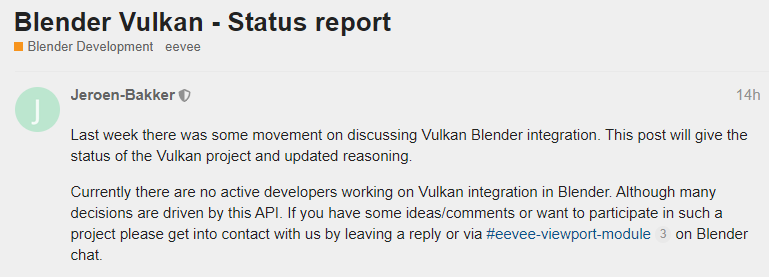The Blender team, an open source 3D modeling software, has released the Blender Vulkan – Status Report to show the community the current progress of Vulkan support. Sadly, there are currently no active developers working on Vulkan integration in Blender.

Why support Vulkan in Blender?
Blender wants to replace the current OpenGL with Vulkan, one because Vulkan is replacing OpenGL (actually Vulkan was named OpenGL Next when it was released in 2015), the OpenGL standard has not undergone any core changes since the introduction of Vulkan 1.0, its development has stalled.
Second, OpenGL drivers work differently internally and are optimized differently for NVIDIA and AMD, and driver issues can cause performance degradation in Blender. As a low-level API, Vulkan solves this problem. It is more suitable for the way actual hardware works and is more friendly to driver development.
What have you done so far?
However, so far, Vulkan support has only been designed to add Vulkan to Blender’s system. This system includes the drawing manager introduced in Blender 2.8, whose structure is similar to Vulkan’s data types and structures. The second is to abstract all communication between Blender and the GPU, making it compatible with different GPU backends, whether for OpenGL, Vulkan or Metal. Finally, the Blender GLSL compilation for the Vulkan platform is completed.
What needs to be done now?
The most important task now is to hurry upImplementing the GPU Vulkan backend. This is the hardest work, GPU data types need to get Vulkan specific implementation. Including but not limited to (backend, compute, context, framebuffer, index buffer, query, shader, state, store buffer, texture, vertex array, vertex buffer, debug).
After implementing the GPU Vulkan backend, it is also necessary to implement GHOST_ContextVK and a selector that gives the user the option to start Blender with OpenGL or Vulkan. It does look like there is still a long way to go.
#Blender #Releases #Vulkan #Support #Status #Report #Undeveloped